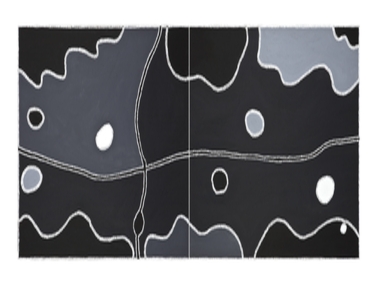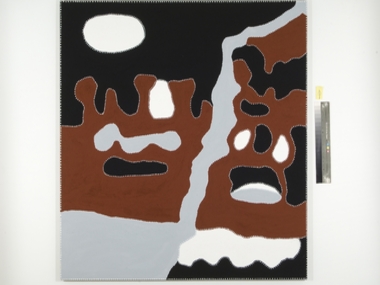EAST KIMBERLEY IN SYDNEY

Freddy Timms 'Barramundi Hole' (Diptych), 2008
Posted by Jeremy Eccles | 04.03.10
Dates:
03.03.10
: 30.03.10
Location: Michael Reid Gallery, 44 Roslyn Gardens, Elizabeth Bay, Sydney
Upon seeing the painting 1957 #20 by Mark Rothko at the National Gallery of Australia, Rover Thomas, the star of the original group of East Kimberley painters, asked: ‘Who’s that bugger who paints like me?’. Rothko himself was not averse to disturbing the chronology of artistic synchronicity. When he saw an exhibition of Turner’s painting in New York in 1966, Rothko posed a similar question: ‘This man Turner, he learnt a lot from me!’ One symbolically reflected on the upheavals of the industrial revolution, the other on the catastrophes of the holocaust. Similarly, the art of Rover Thomas and his contemporaries is as much a response to the deadly consequences that followed the coming of Europeans and their cattle to The Kimberley as it is about land and ancestral law.
The revelation of the Kurirr Kurirr ceremony to Rover Thomas, in the wake of both the decline in ceremonial practices that followed the exclusion of stockmen from their traditional lands and the destruction of Darwin by the Rainbow Serpent (their interpretation of Cyclone Tracy) in 1974, was part of a great cultural revival. It also marked the genesis of one of the great movements in contemporary Aboriginal art – the East Kimberley school of painting based at Warmun. For performers in the Kurirr Kurirr ritual needed to carry painted boards to illustrate their chant and dance. Through a kin relationship to Rover, Paddy Jaminji was invited to paint the Kurirr Kurirr boards; his collaborators included George Mung Mung.
Mung Mung's son-in-law, Freddie Timms had worked with Rover as a stockman on Bow River and Texas Downs stations. He too was among the first group of artists who painted boards in the late 1970s. Now, with Rusty Peters, he's at the forefront of the second wave of painters from the East Kimberley.
Following Rover’s lead, the style of painting in the region is based on land as a mnemonic of ancestral and historical events: the land bears the scars of history, both ancient and recent. Freddie’s imagery draws upon the trails of a stockman across the land, informed by ancestral beliefs. Much of the country he worked on Lissadell Station is now the subject of his paintings, though it now lies under the waters of Lake Argyle that was formed with the damming of the Ord River in the 1960s.
Rusty Peters was schooled in traditional law by his father and grandfather, and after the chaos of the dislocation of Aboriginal cattle-station workers in the 1970s, he eventually settled at Warmun where he was instrumental in establishing a school and in maintaining the Gija language. A ritual songman and teacher, Rusty’s art is the visual expression of tradition and the law. Rusty was an old friend of Rover Thomas and a close companion in the latter years of Rover’s life.
The uniting feature of the art of these cattlemen-now-painters is, to borrow from the title of Simon Schama’s influential book, Landscape and Memory; it also links Rothko to Turner. But how did these stockmen become artists of such substance? Above all, they are men of the law, and intent on preserving the law in modern times through a distinctive visual language that transcends time and place; yet it's deeply rooted in both.
The selling exhibition - mainly of works by Timms and Peters from the Jirrawun Studio - forms part of Art Month Sydney - founded by Michael Reid to stimulate the art business in parlous times.
URL: michaelreid.com.au
Share this:
»  del.icio.us
»
del.icio.us
»  Digg it
»
Digg it
»  reddit
»
reddit
»  Google
»
Google
»  StumbleUpon
»
StumbleUpon
»  Technorati
»
Technorati
»  Facebook
Facebook
Contact Details

Rusty Peters 'My Fathers Uncle’s Country', 2008 Ochres, pigment with acrylic binder on Belgian linen, 123.0 x 120.0 cm
Further Research
Artists: Freddy Timms | George Mung Mung | JMW Turner | Mark Rothko | Paddy Jaminji | Rover Thomas | Rusty Peters
News Tags: Art Month Sydney | East Kimberley | Mark Rothko | Michael Reid | Rover Thomas | Wally Caruana
News Categories: Australia
Exhibition Archive
- 10.10.17 | TARNANTHI 2017
- 11.08.17 | Natsiaas 2017
- 20.07.17 | APY ART DOMINATES THE WYNNE
- 17.07.17 | Anangu Artist Wins $100,000 Prize
- 14.07.17 | The End of AAMU
- 11.07.17 | ART ACROSS THE COUNTRY
- 11.07.17 | TARNANTHI IN OCTOBER
- 05.07.17 | TJUNGUṈUTJA - from having come together
- 13.06.17 | Ghost-Nets Straddle the World
- 07.06.17 | Grayson Perry Going Indigenous?
- 05.06.17 | Barks Bigger than Ben Hur
- 27.05.17 | NGA QUINQUENNIAL 2017
- 21.05.17 | Blak Douglas Finds Home at the NGA
- 21.05.17 | BRIAN ROBINSON WINS HAZELHURST WOP
- 18.05.17 | PARRTJIMA 2.0
Advertising

